
In vascular plants, the roots are the organs of a plant that are modified to provide anchorage for the plant and take in water and nutrients into the plant body, which allows plants to grow taller and faster. They are most often below the surface of the soil, but roots can also be aerial or aerating, that is, growing up above the ground or especially above water.

Tubers are a type of enlarged structure used as storage organs for nutrients in some plants. They are used for the plant's perennation, to provide energy and nutrients for regrowth during the next growing season, and as a means of asexual reproduction. Stem tubers form thickened rhizomes or stolons ; well known species with stem tubers include the potato and yam. Some writers also treat modified lateral roots under the definition; these are found in sweet potatoes, cassava, and dahlias.

Groundcover or ground cover is any plant that grows over an area of ground. Groundcover provides protection of the topsoil from erosion and drought.
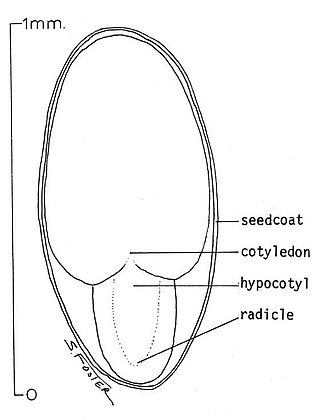
The hypocotyl is the stem of a germinating seedling, found below the cotyledons and above the radicle (root).
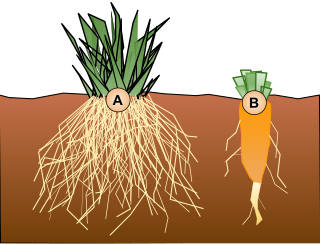
A taproot is a large, central, and dominant root from which other roots sprout laterally. Typically a taproot is somewhat straight and very thick, is tapering in shape, and grows directly downward. In some plants, such as the carrot, the taproot is a storage organ so well developed that it has been cultivated as a vegetable.
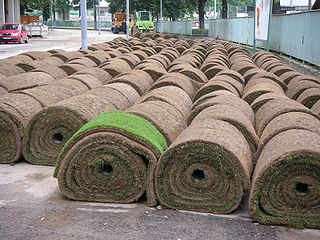
Sod, also known as turf, is the upper layer of soil with the grass growing on it that is often harvested into rolls.

Aeroponics is the process of cultivating plants in an air or mist environment, eliminating the need for soil or an aggregate medium. The term "aeroponic" originates from the Greek words aer ("air") and ponos ("work"). It falls under the category of hydroponics, as water is employed in aeroponics to deliver nutrients to the plants.

In biology, stolons, also known as runners, are horizontal connections between parts of an organism. They may be part of the organism, or of its skeleton. Typically, animal stolons are exoskeletons.
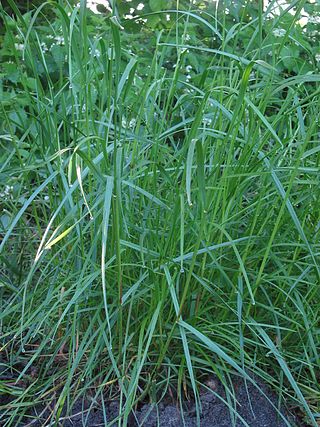
Lolium perenne, common name perennial ryegrass, English ryegrass, winter ryegrass, or ray grass, is a grass from the family Poaceae. It is native to Europe, Asia and northern Africa, but is widely cultivated and naturalised around the world.

Hordeum jubatum, with common names foxtail barley, bobtail barley, squirreltail barley, and intermediate barley, is a perennial plant species in the grass family Poaceae. It occurs wild mainly in northern North America and adjacent northeastern Siberia. However, as it escaped often from gardens it can be found worldwide in areas with temperate to warm climates, and is considered a weed in many countries. The species is a polyploid and originated via hybridization of an East Asian Hordeum species with a close but extinct relative of Californian H. brachyantherum. It is grown as an ornamental plant for its attractive inflorescences and when done flowering for its inflorescence.

Take-all is a plant disease affecting the roots of grass and cereal plants in temperate climates caused by the fungus Gaeumannomyces tritici. All varieties of wheat and barley are susceptible. It is an important disease in winter wheat in Western Europe particularly, and is favoured by conditions of intensive production and monoculture.

Agropyron cristatum, the crested wheat grass, crested wheatgrass, fairway crested wheat grass, is a species in the family Poaceae. This plant is often used as forage and erosion control. It is well known as a widespread introduced species on the prairies of the United States and Canada.
Pythium aristosporum is a species of pythium under the class oomycota that causes root dysfunction in creeping bentgrass.
This page provides a glossary of plant morphology. Botanists and other biologists who study plant morphology use a number of different terms to classify and identify plant organs and parts that can be observed using no more than a handheld magnifying lens. This page provides help in understanding the numerous other pages describing plants by their various taxa. The accompanying page—Plant morphology—provides an overview of the science of the external form of plants. There is also an alphabetical list: Glossary of botanical terms. In contrast, this page deals with botanical terms in a systematic manner, with some illustrations, and organized by plant anatomy and function in plant physiology.
This glossary of botanical terms is a list of definitions of terms and concepts relevant to botany and plants in general. Terms of plant morphology are included here as well as at the more specific Glossary of plant morphology and Glossary of leaf morphology. For other related terms, see Glossary of phytopathology, Glossary of lichen terms, and List of Latin and Greek words commonly used in systematic names.
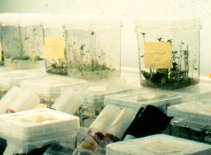
Plant tissue culture is a collection of techniques used to maintain or grow plant cells, tissues, or organs under sterile conditions on a nutrient culture medium of known composition. It is widely used, to produce clones of a plant in a method known as micropropagation. Different techniques in plant tissue culture may offer certain advantages over traditional methods of propagation, including:
The Vetiver System (VS) is a system of soil and water conservation whose main component is the use of the vetiver plant in hedgerows. It is promoted by the Vetiver Network International (TVNI), an international non-governmental organization.
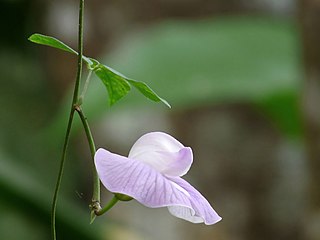
Centrosema pubescens, common name centro or butterfly pea, is a legume in the family Fabaceae, subfamily Faboideae, and tribe Phaseolae. It is native to Central and South America and cultivated in other tropical areas as a forage for livestock.
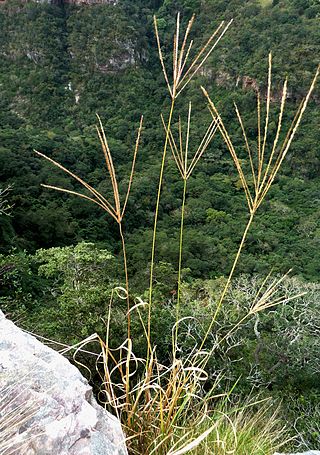
Digitaria eriantha, commonly known as digitgrass or Pangola-grass, is a grass grown in tropical and subtropical climates. It grows relatively well in various soils, but grows especially well in moist soils. It is tolerant to droughts, water lodging, suppresses weeds and grows relatively quickly after grazing. This grass demonstrates great potential for farmers in Africa in subtropical and tropical climates, mostly for livestock feed.
Phenotypic plasticity is the ability of an individual organism to alter its behavior, morphology and physiology in response to changes in environmental conditions. Root phenotypic plasticity enables plants to adapt to an array of biotic and abiotic constraints that limit plant productivity. Even though the exploitation of soil resources through root activity is energetically costly, natural selection favors plants that can direct root activity to exploit efficiently the heterogeneous distribution of soil resources.















